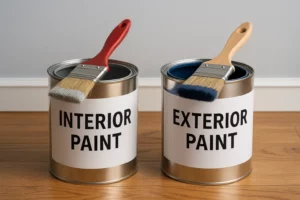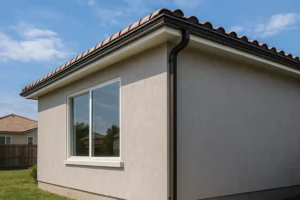You’re standing in the garage, looking at half-full cans of paint from past projects. One is marked “interior.” The other is “exterior.” And now you’re wondering:
Can you mix interior and exterior paint to save money or use up leftovers?
It’s a common question—and a smart one to ask before you start brushing walls or painting trim. At Ground Up Construction, we’ve seen plenty of DIY projects go sideways because of mismatched paints or misunderstood products. Mixing paint sounds simple, but it can lead to big problems if you’re not careful.
In this blog, we’ll explain exactly why interior and exterior paints are different, whether you can (or should) mix them, and how to get the best results for your home, inside and out.
Building Better From the Ground Up
Before we answer, let’s talk about what makes these paints different in the first place.
Interior Paint
Interior paint is made for walls and ceilings inside your house. It helps make your home look good and can handle everyday bumps and spills.
- Strong and Easy to Clean: Interiorpaint doesn’t scratch easily, and you can wipe off dirt with soap and water. This keeps your walls looking nice for a long time.
- Less Smell and Safer Air: This paint doesn’t have a strong smell and has fewer bad chemicals. This makes the air inside your house healthier to breathe.
- Not for Outside: Interior paint will get ruined if it gets rained on or is in the sun too much.
Exterior Paint
Exterior paint is made for the outside parts of your house, like the walls and wood trim. It’s made to protect your house from the weather.
- Stays Looking Good: Exterior paint won’t fade in the sun, crack, or let water soak in. This keeps your house looking good even when the weather is bad.
- Special Things Added: Exterior paint has stuff in it to stop mold from growing. It also stretches when it gets hot or cold so it doesn’t crack. And it blocks the sun so the color doesn’t disappear.
- Handles Hot and Cold: Exterior paint can handle very hot and very cold weather without getting ruined. It also does well when it’s very humid (lots of moisture in the air).
In short: Exterior paint is built tougher, while interior paint is designed to be safer and smoother for indoor spaces.
So... Can You Mix Interior and Exterior Paint?
Here’s the quick answer:
While it is physically possible to mix interior and exterior paint, it is not a good idea.
Here’s why:
The paint won’t behave the same.
Paints are formulated for specific conditions. When you mix them, the finish, durability, and color performance may not work as expected.
You could risk peeling, cracking, or early fading.
Especially on exterior surfaces, the wrong paint formula can break down much faster in sun, rain, and wind.
What Happens If You Use the Wrong Paint?
If you mix or misuse interior and exterior paint, here’s what might happen:
- Inside your home: That “extra-tough” exterior paint might seem like a good idea, but it could release higher VOCs (volatile organic compounds) that create strong odors or even affect air quality over time.
- On your exterior: If you apply mixed or interior paint to outdoor walls, you risk peeling, fading, and water damage. San Diego’s sun is strong, and our coastal air has moisture—paint that isn’t UV- and mildew-resistant won’t last.
Bottom line: Each paint is designed for a purpose. Mixing them makes them less effective at both.
Can You Use Exterior Paint Indoors?
Even though you might have some leftover exterior paint, it’s usually not a good idea to use it inside your house. Exterior paints have special components to help them survive tough weather like rain and sun. Some of them are strong chemicals that fight off mold and yucky stuff that grows outside. These chemicals also make fumes called VOCs as the paint dries. Outside, these fumes disappear pretty fast because there’s lots of air.
But inside, it’s different. If you use outside paint inside, those strong chemicals and fumes can stick around. Breathing them in for a long time can make people feel sick, like getting headaches or feeling queasy. This is especially true if someone is sensitive to smells.
Also, outside paint is made to be tough and handle rough weather. This can make it thick and not very smooth. So, your walls might feel a bit rough if you use it inside. Plus, outside paint is often super shiny to protect it from the weather. But inside, really shiny walls can look a bit too bright and not very cozy.
So, while you could technically paint inside with outside paint, it’s better to use paint made just for indoor walls. That way, it’s safer and will look much better.
Can You Use Interior Paint Outside?
Short answer: Definitely not.
Think of indoor paint like clothes made only for being inside. It’s good for keeping walls looking nice inside your house because it can be wiped clean and doesn’t smell too strong. But if you wear those inside clothes outside in the rain and sun all the time, they’ll quickly get ruined.
Indoor paint is similar. It’s made for the gentle conditions inside. It’s not tough enough for the rough outdoor weather.
One big problem is the sun. The sun’s strong rays, called UV, are like a superhero that can break down the stuff that gives indoor paint its color. So, if you use indoor paint outside, the color will fade super fast, maybe in just a few months. Your bright blue wall could turn into a sad, pale blue.
Rain, snow, and damp air are also enemies of indoor paint. These things can make the paint soft and bubbly, and then it will start to peel right off your walls. This doesn’t just look bad; it can also let water get into the wall and cause more serious damage like rot or mold.
Also, houses move a little bit as the weather changes – they expand when it’s hot and shrink when it’s cold. Outdoor paint is made to stretch and move with the house. Indoor paint is not as stretchy, so it will likely crack and become weak when the weather changes. This means you’ll have to repaint much sooner.
So, even though using leftover indoor paint outside might seem like a good idea to save money, it will actually cause more problems and cost you more in the long run. You’ll end up having to repaint everything again with the right kind of outdoor paint anyway, plus you might have to fix any damage the bad paint caused. It’s always best to use paint that’s made for being outside if you’re painting something outside!
What Should You Do Instead?
If you’ve got leftover paint, here are smarter ways to use it:
- Interior paint: Save for small indoor projects like closets, garage walls, or furniture (as long as it’s protected inside).
- Exterior paint: Use for touch-ups on siding, fences, or sheds—anything that stays outdoors.
If you need a professional opinion or a fresh coat on your exterior, check out our exterior paint and stucco services at Ground Up Construction. We’ll help you choose the right product for the job—no guessing, no wasted paint.
Tips for Choosing the Right Paint for Your Home
Here are a few quick tips to keep your paint projects stress-free:
- Check the label: If it says “interior” or “exterior,” trust it. The formulas are made for specific conditions.
- Match the environment: Use paint designed for where it’s going—walls, trim, siding, etc.
- Don’t cut corners: It might be tempting to save a few bucks by mixing paints, but it often leads to bigger costs down the road.
- Test before you commit: If you’re unsure about color or finish, test a small area first.
- Call the pros when in doubt: We’re always happy to help you figure out the best paint for your space. Just contact us and we’ll answer your questions.
Why Choose Ground Up Construction for Your Painting Projects?
At Ground Up Construction, we’ve helped homeowners across San Diego tackle everything from simple touch-ups to full exterior repaints. Here’s what makes us different:
- Local expertise – We know how San Diego’s sun, moisture, and salt air affect different materials.
- Honest advice – We’ll help you choose the right product, even if it’s not the most expensive one.
- High-quality materials – We use top-rated paints designed to last in our climate.
- Careful prep and application – The key to a long-lasting paint job is proper prep—and we don’t skip steps.
- Full-service solutions – From patching stucco to repainting your home, we handle it all.
Our goal is simple: help you make smart choices and love the way your home looks.
Ready for a Paint Job That Lasts? Let’s Talk.
Mixing interior and exterior paint might sound like a good idea—but it rarely is. If you’re ready to upgrade your home’s exterior (or tackle a fresh coat inside), let’s make a plan together.
Contact Ground Up Construction today. We’ll help you choose the right paint, handle the hard work, and leave your home looking better than ever.



